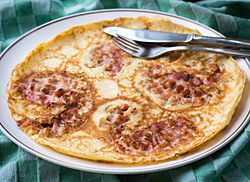This article needs additional citations for verification. (January 2011) |
 Pannenkoek with bacon | |
| Course | Main course |
|---|---|
| Place of origin | |
| Region or state | Northwestern Europe |
| Serving temperature | warm |
| Main ingredients | Flour, milk, and eggs |
A pannenkoek[1][2] (Dutch pronunciation: [ˈpɑnə(ŋ)ˌkuk] ; plural pannenkoeken [-ˌkukə(n)] ) or Dutch pancake is a style of pancake with origins in the Netherlands.[3] Pannenkoeken are usually larger (up to a foot in diameter) and much thinner than their American or Scotch pancake counterparts, but not as thin as crêpes.[citation needed] They may incorporate slices of bacon, apples, cheese, or raisins. Plain ones are often eaten with treacle (syrup made of sugar beets), appelstroop (an unspiced Dutch variety of apple butter) or (powdered) sugar and are sometimes rolled up to be eaten by hand or with cutlery.
Basic ingredients are flour (plain, self-rising or both), milk, salt, and eggs. The addition of buckwheat flour (up to 50 percent) is traditional, but much less common nowadays. Milk can be replaced with soy milk without changing the end result.
The ingredients are beaten into a batter of a fairly liquid consistency. A ladle of batter is then pan fried in butter or oil. Once the top of the pannenkoek is dry and the edges start to brown, it can be flipped over. The first one is often less than perfect. At home a stack of pannenkoeken can be made in advance so everyone can eat at the same time, or people can take turns at the stove.
Pannenkoeken can be, and often are, eaten as a main course, served warm; in winter pannenkoeken are sometimes eaten after snert in a two course meal. Pannenkoeken are a popular choice for a child's birthday meal in the Netherlands and Belgium. Specialised pannenkoeken restaurants are common in the Netherlands and Belgium ("pannenkoekenhuizen" = pancake houses). They often offer a very wide range of toppings and ingredients, traditional and modern (e.g. cheese, oregano and salami on a pizza-pannenkoek).
Dutch and Belgian supermarkets offer pre-cooked (microwavable) pannenkoeken as well as pre-made batter and dry flour mixes. The latter only needs added water.
- ^ The spelling, with or without intermediate -n, is a matter of discussion. According to the 2005 Groene Boekje, which reflects the official spelling norm, pannenkoek is correct, while the 2006 Witte Boekje, which is a private spelling norm, allows both. See "Pannekoek of pannenkoek?". Genootschap Onze Taal. Retrieved 12 January 2011.
- ^ "pannenkoek / pannekoek*". www.taaltelefoon.be (in Dutch). Retrieved 2018-01-09.
- ^ Sharron L. McElmeel, McElmeel, Sharron; Deborah L. McElmeel (2006). Authors in the pantry: recipes, stories, and more. Libraries Unlimited. pp. 49–50. ISBN 978-1-59158-321-9.